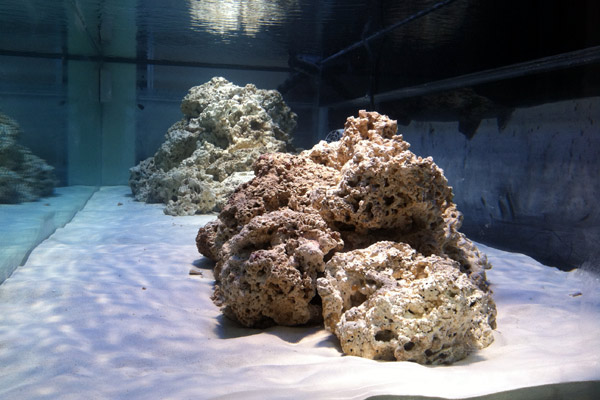The choice of substrate—the material placed on the bottom of the tank—for a saltwater aquarium is one of many areas in our hobby that generate confusion and disagreement. Ask 10 hobbyists which type and depth of substrate they would recommend, and you’ll likely get 10 different answers. The truth is, there’s no single substrate particle size or depth that’s appropriate for every system under all circumstances.
Let’s drill down a little deeper into this topic so you’ll be equipped to choose the right substrate for your system based on your individual goals.
What does the substrate do?
A substrate does much more than just lie there and look pretty. Beyond creating a nice ocean-floor aesthetic, the substrate can perform many important functions. Among them:
- Providing biofiltration by supporting colonies of the beneficial aerobic bacteria that convert ammonia to less toxic compounds
- Providing a suitable home for various beneficial microfauna, such as amphipods, copepods, tiny brittle stars, etc.
- Providing appropriate conditions for burrowing, burying, and sand-sifting species, such as jawfish, various wrasses, certain gobies, Cerithium spp. snails, etc.
- If depth and grain size are appropriate (at least 4 inches of fine sand), supporting colonies of anaerobic bacteria that convert nitrate to harmless free nitrogen gas
Keep it calcareous!
Forget the colored quartz gravels widely used by freshwater aquarium hobbyists. Ideally, the substrate medium you choose should be calcareous, or composed of calcium carbonate. Some common types include aragonite, crushed coral or coral sand, and crushed seashells of various grain sizes. Aragonite is one of the better choices because it dissolves at a relatively high pH, which means it will do a good job of buffering the pH of the water at a level appropriate for marine livestock.
What grain size should I go with?
Again, the answer here depends on your livestock and filtration goals. For example, if you plan to keep a fish that feeds by taking in mouthfuls of substrate and expelling it through its gills, such as one of the Valenciennea spp. sleeper gobies, a very fine-grained, smooth-edged (e.g., oolitic) sand would be appropriate. Burrowing species, such as the yellowhead jawfish, need a substrate of mixed particle sizes, including rubble, to construct a sturdy burrow. If you plan to install a deep sand bed (DSB) for the purpose of natural nitrate reduction, very fine sand is the medium of choice.
On the other hand, if you aren’t keeping burrowing or sand-sifting species, you aren’t interested in natural nitrate reduction with a DSB, and your only concern is having an aesthetically pleasing substrate, the grain size is really up to you. Just keep in mind that the larger the grain size of your substrate medium, the more it will tend to trap detritus in the voids between particles, which necessitates regular vacuuming.
How deep is deep enough?
If you plan to incorporate a DSB in your setup and/or to keep burrowing/sand-sifting species, a minimum substrate depth of four inches is recommended. Otherwise, a depth of just a few inches is more than adequate to give your aquarium a nice natural look and provide the right environment for aerobic nitrifying bacteria to flourish.
Believe it or not, some hobbyists choose to leave their bottoms completely exposed—their tank bottoms, that is. With so-called bare-bottom (BB) tanks, you never have to worry about the substrate trapping particulate waste and becoming an ongoing source of dissolved pollutants. The tradeoff is that they’re not as natural-looking, however.




hi Jeff, i’m a newbie in this hobby,i’m from Malaysia, i’ve just setup my new 5 feet (L) x 3feet (T) x 2.5 feet (W) main tank..now i’ve just taken the next step collecting natural sea sand far from the sea shore which is clean..
my question is can i immediately put the sand directly into my tank or should i store it first? or should i clean the sand with tap water?
my next step after i put the sand in my tank, i’ll will start collecting natural sea water and start to run filtration system in my tank so that the water will be clear and clean..is it the correct step?
need your advice..thanks
Hi All
I am new to saltwater and I am just cycling my new tank.
I believe it was somewhere here that I had seen something on Rusty Brown spots on the sand and rocks in the early stages of the cycle.
I just can’t find it again as when I read about it there was nothing happening in my tank at that time.
The tank is in the second week of cycling and I want to know if this is a good thing and if it will go away on its own as time goes on or is it something I need to get out of there myself.
Hi Don! the rusty brown spots are likely a diatom bloom, which is a normal (albeit unsightly) occurrence in any newly established system. It should be self-limiting as the nutrients fueling the diatoms are used up.
Thank you this helps a lot I thought that is what I had seen somewhere here
My pleasure, Don!
Can you do ultra fine sand on say the right side and a coarser grain on the left
I don’t see why not. Are you planning to designate an area of the tank for a sand-sifting species or for nitrate reduction? Just curious why you want to go half and half.
This post is really great and helpful. Thanks for sharing this to us. This helps homeowners when setting up aquarium in their house. Keep posting.
Thanks for stopping by and leaving a comment, Kendra. Glad you liked the post!